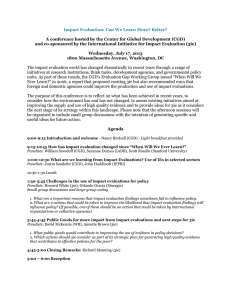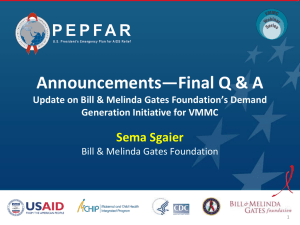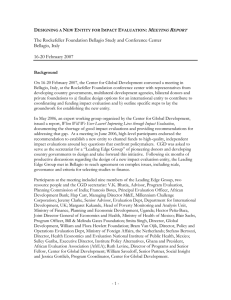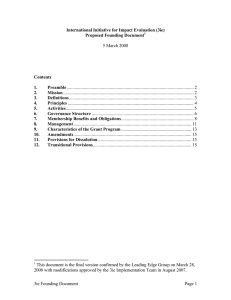What is a stakeholder engagement and evidence uptake plan (SEEP)?
advertisement
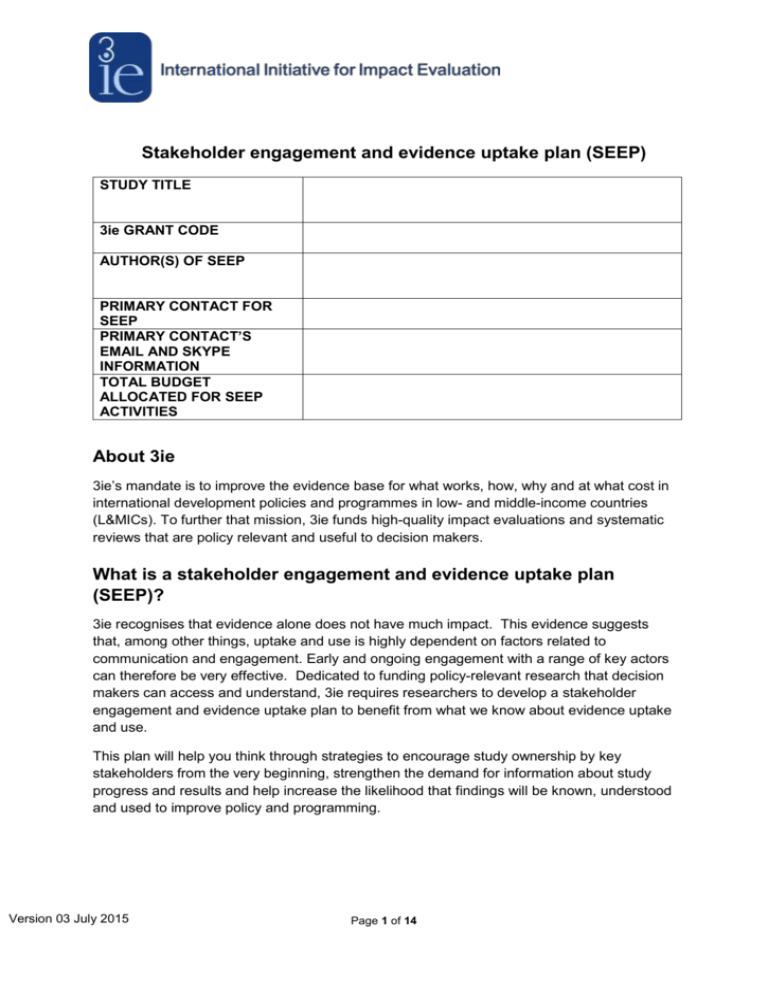
Stakeholder engagement and evidence uptake plan (SEEP) STUDY TITLE 3ie GRANT CODE AUTHOR(S) OF SEEP PRIMARY CONTACT FOR SEEP PRIMARY CONTACT’S EMAIL AND SKYPE INFORMATION TOTAL BUDGET ALLOCATED FOR SEEP ACTIVITIES About 3ie 3ie’s mandate is to improve the evidence base for what works, how, why and at what cost in international development policies and programmes in low- and middle-income countries (L&MICs). To further that mission, 3ie funds high-quality impact evaluations and systematic reviews that are policy relevant and useful to decision makers. What is a stakeholder engagement and evidence uptake plan (SEEP)? 3ie recognises that evidence alone does not have much impact. This evidence suggests that, among other things, uptake and use is highly dependent on factors related to communication and engagement. Early and ongoing engagement with a range of key actors can therefore be very effective. Dedicated to funding policy-relevant research that decision makers can access and understand, 3ie requires researchers to develop a stakeholder engagement and evidence uptake plan to benefit from what we know about evidence uptake and use. This plan will help you think through strategies to encourage study ownership by key stakeholders from the very beginning, strengthen the demand for information about study progress and results and help increase the likelihood that findings will be known, understood and used to improve policy and programming. Version 03 July 2015 Page 1 of 14 Ensuring that the plan is appropriate to your role as the evaluation team 3ie expressly cautions against the promotion of findings from single studies without seating findings in the broader evidence base. Researchers have a necessary and vital role to play as communicators of evidence so that policymakers and implementers understand and use your information in appropriate ways. This plan takes into account where timely and appropriate communication and engagement by researchers makes the most contribution. We also know that there are limits to what researchers can do in promoting evidence use from a given study. Knowledge intermediary Actively engaging in policy and policy practice debates: taking part in meetings and providing expert advice Knowledge translator Translating research evidence for non specialist audiences: holding workshops, consultations and writing policy briefs Information intermediary Making information available: putting research into the public domain Moving from dissemination to engagement (Adapted from Fig 4: The spectrum of knowledge functions in the Global Mental Health Policy Toolkit developed by ODI) Realistic expectations from a plan Change in policy or programme may take longer than the life of the grant. However, evidence is much more likely to contribute to that change if the team does lay down the foundation with effective communication and engagement approaches. The plan and its implementation are 3ie grant requirements We strongly recommend that you develop your plan in the team and in collaboration with the implementing agency as appropriate. You may reach out to 3ie for any inputs or constructive feedback as you develop your plan. A completed SEEP must be approved by 3ie before the first tranche for full impact evaluation is disbursed. For each reporting cycle, grantees will be required to report on their policy and programming engagement and uptake activities (as per the guidelines in Error! Reference source not found. of this document). The plan is a living document and an active strategy. Policy and programme implementation contexts are dynamic. Opportunities for engagement emerge or change regularly and this should be reflected in evolving approaches to engagement over the life of the project. Version 03 July 2015 Page 2 of 14 CONTEXT ANALYSIS GUIDANCE The political economy context for evidence production is an important determinant in whether or not the evidence is likely to be taken up and used (see guidance box for relevant resources). Usually, the main driver is the political context, which includes the political system- actors and institutionsand the power dynamics both among and within the institution. For example, whether it is a relatively open and democratic or a closed and autocratic society, or if it is a fragile and in-conflict society where political institutions are weak or non-functioning. This is likely to impact how knowledge circulates and how decisions are taken. It would hence be important to consider if knowledge is public, or whether critical debates and decisions take place in private networks and behind closed doors? Political context, while outside of the control of the study, is an important consideration to make given its potential impact. Context analysis is crucially important for ensuring quality study design and implementation, but also for understanding how, when and with whom to communicate and engage. The guidance box lists some indicative questions that are useful to consider in your analysis. Version 03 July 2015 Page 3 of 14 DFID Political Economy Analysis How to Note, 2009 www.odi.org/publications/4797political-economy ODI Political economy analysis framework http://www.odi.org/sites/odi.org.uk/files /odi-assets/publications-opinionfiles/8334.pdf What are the knowledge or evidence gaps in policy and practice that the study is hoping to address? What opportunities does the context present, which make this evaluation and the issues it seeks to address timely and relevant? Is there demand from policymakers and/or programme implementers for the kind of evidence the evaluation is designed to provide? Is there a culture of using evidence for decision making by those directly involved in the study and by those not directly involved but who could benefit from knowing about its findings (such as the public, government, the media, academia)? Are you working in a country that has a formalised system for the use of evidence? Is independent evidence looked upon favourably in the political context? RISKS GUIDANCE All undertakings have risk. Doing a risk register of both the controllable and the uncontrollable is an important study management tool. Below we provide an indicative list of some risks that the research teams might face during the course of the study. Certain contextual factors present risks that, if not adequately recognised and mitigated, could hamper or even derail uptake of study findings. Risks in your immediate environment of the programme and implementing agency are important to identify given that there may be risks related to study ownership, understanding of the study design and objectives, and expectations about the findings (especially findings with no or negative impact) by the implementing agency and other key actors. Using the template below, please list all risks, both controllable and the uncontrollable that you are likely to face, focussing first on risks that you can manage or mitigate through communication and engagement. You can add additional rows below for more risks that may have been identified. Examples of risks amenable to mitigation by the team: Null or negative findings (you manage expectations and explain the findings clearly) Opposition from actors who are against implementation or success of the programme being evaluated Tight budgets in the implementing agency ( you include cost-effectiveness findings and ensure recommendations are financially feasible) Over reliance on one key stakeholder Screening of findings to suit vested interests lobbied by a few Lack of ownership among stakeholders of the intervention being evaluated Risks related to successful implementation of the programme being evaluated Disinterested project staff and/or beneficiaries Chance that no one with power knows about the findings Examples of risks that are hard to control or outside the team’s control that could negatively impact study results or uptake and use: Version 03 July 2015 Page 4 of 14 Upcoming elections that prevent actors from taking positions or actions needed to support policy change Limited freedom of press High political or staff turnover. Risk 1: Mitigating action (if possible): Risk 2: Mitigating action (if possible): Risk 3: Mitigating action (if possible): Version 03 July 2015 Page 5 of 14 SUMMARY OF ENGAGEMENT DURING THE PROPOSAL PREPARATION GRANT (PPG) PHASE In your application proposal you briefly noted the process followed during the PPG phase for ensuring engagement with the implementing agency. Here we expect you to elaborate on the process by summarising the activities undertaken during the PPG phase, both with the implementing agency and other stakeholders. Please also highlight feedback or inputs received on study design and questions and how this feedback was incorporated or addressed in the design proposed to 3ie. You are requested to be specific in your information about the details related to each activity below as well as the stakeholders met. To the extent possible, please provide the names of the stakeholder and their institutional affiliation and their position in the institution. The guidance box provides broad expectations around engagement. Using the table below, please highlight efforts undertaken by the team to establish ongoing dialogue and promoting ownership of the study. Objective Activities undertaken (include highlights from the discussion and action points) Promoting understanding of the IE, including preparing the IA for findings of no or negative impact Ensuring involvement of IA and other stakeholders in the study design and identifying the research questions Establishing the policy relevance of the evaluation Version 03 July 2015 Page 6 of 14 GUIDANCE Below is an indicative list of activities that 3ie expects the grantee to undertake, as communicated in the RFQ or the introductory calls. Establish an ongoing dialogue with the implementing agency staff to ensure buy-in and increase ownership to encourage uptake of study findings. Hold at least one workshop with the implementing agency staff to increase understanding of impact evaluation and develop the programme theory of change, evaluation questions and timeframes for evaluation. Carry out scoping and other background information needed to ensure that the full evaluation proposal is relevant to the programme and policy needs and priorities of the implementer and identify any global public goods, as in filling a priority evidence gap, needed beyond the immediate study context. Who participated (name and affiliation) EVIDENCE UPTAKE AND USE OBJECTIVES GUIDANCE We recognise that your primary objective is to implement a study that leads to sound findings. However, as noted earlier, 3ie believes that the role of the study team extends beyond evidence production since the mere presence of evidence is usually not enough to promote use. Specific – do the evidence uptake and use objectives specify what is to be achieved clearly enough to be monitored? Your objectives should be SMART: We would like you to summarise your main objectives for evidence uptake and use, in the light of the type of evidence that you expect to produce and the context in which it will be communicated. We encourage you to try and limit objectives to not more than three. Measurable – can you monitor your progress on the objectives that you have set out for yourself? (see section on Evaluation and Learning) Achievable – are the objectives realistic given the resources available to you? This could include resources in addition to 3ie funding. Relevant – is the study design likely to produce findings that will be useful, even if null? Time-bound – have you identified objectives that can be achieved within the timeframe of this project? Longer term: Some objectives may not be achievable during the study, but setting goals is important to ensure work is done to promote the conditions needed to achieve them. Note: Your objectives could be influencing strategy and resource allocation within the implementing agency, or higher order objectives like reframing the debate on the issue being studied, informing programmatic approach either nationally or globally, facilitating enactment or elimination of a specific legislation or building an alliance or network around a specific policy recommendation. Version 03 July 2015 Page 7 of 14 STAKEHOLDER ANALYSIS Your engagement and evidence uptake and use objectives will help define your key stakeholders for the study and its findings. A comprehensive analysis of stakeholders who are likely to be key in the uptake of research findings is an important precursor to drafting a successful stakeholder engagement and communication strategy. Identify key individuals and groups that will be essential to your engagement as well as groups that may hinder your engagement and evidence uptake efforts (detractors). Provide analysis of how and why these actors will be beneficial and how you plan on engaging with them. Version 03 July 2015 Page 8 of 14 HOW TO DO A STAKEHOLDER ANALYSIS Appended to the document is a 3ie worksheet for stakeholder mapping and analysis (Error! Reference source not found.). The worksheet provides a step wise approach to doing a robust stakeholder analysis and mapping your key stakeholder and influencers. Note: 3ie doesn’t require you to submit the filled out worksheets. A summary of the findings from the exercise can be provided to us here. KEY INFLUENCERS Identify at least three stakeholders (we would expect you to have more in most instances) with the potential to influence policy in the area addressed by your evaluation and explain your selection. Key influencers include various groups when they are in a position to influence policy and programming, such as policymakers, media, civil society organisations, professional associations and trade unions, religious groups and traditional leaders, private sector and so on. Not all contacts should be at the project level, nor, generally speaking, should your first three all be from government. You may add additional contacts if you wish in separate sheets. ONE Name: Name of organisation: Position: Website: Contacts: (email or telephone number) Type of organisation: (Government agency- central, regional or local; civil society organisations; international organisations, research organisations, think tanks, development agencies, media, trade unions or professional associations, private sector partners and others) Relevance or level of influence: Why is his or her participation important? What role does she or he play in the decision-making process? How much influence or leverage is she or he expected to have? What is his or her perceived interest in the evaluation process? Is she or he part of a particular network (e.g. policy network, policy committees, advisory boards or research communities)? Do you have any previous experience of working with this stakeholder? If so, please elaborate. Version 03 July 2015 Page 9 of 14 TWO Name: Name of organisation: Position: Website: Contacts: (email or telephone number) Type of organisation: (Government agency- central, regional or local; civil society organisations; international organisations, research organisations, think tanks, development agencies, media, trade unions or professional associations, private sector partners and others) Relevance or level of influence: Why is his or her participation important? What role does she or he play in the decision-making process? How much influence or leverage is she or he expected to have? What is his or her perceived interest in the evaluation process? Is she or he part of a particular network (e.g. policy network, policy committees, advisory boards or research communities)? Do you have any previous experience of working with this stakeholder? If so, please elaborate. Version 03 July 2015 Page 10 of 14 THREE Name: Name of organisation: Position: Website: Contacts: (email or telephone number) Type of organisation: (Government agency- central, regional or local; civil society organisations; international organisations, research organisations, think tanks, development agencies, media, trade unions or professional associations, private sector partners and others) Relevance or level of influence: Why is his or her participation important? What role does she or he play in the decision-making process? How much influence or leverage is she or he expected to have? What is his or her perceived interest in the evaluation process? Is she or he part of a particular network (e.g. policy network, policy committees, advisory boards or research communities)? Do you have any previous experience of working with this stakeholder? If so, please elaborate. Version 03 July 2015 Page 11 of 14 STAKEHOLDER ENGAGEMENT AND COMMUNICATION PLAN Please provide a detailed plan for engaging relevant stakeholders throughout the study duration that you identified in your stakeholder analysis. You will report progress on those activities and provide supporting documents including list of participants, key takeaways or follow-up plans from meetings, presentations, blogs, articles, policy briefs, memos and other related knowledge products including publications. Key milestones Why- objectives of the engagement Who- stakeholders How- channels By whom *Specify approximate timelines within each evaluation stages. Please summarise here why you are engaging with the identified stakeholders? e.g. raising awareness, updating on study progress, securing buy-in from sceptics, sharing preliminary results or disseminating final results. Of the stakeholders identified above, please specify which ones you would engage with at what stage of the project Specify the channels to be used for each stakeholder or group of stakeholders (an indicative list is provided below): Team members who will lead on engagement These should be aligned to your deliverables and disbursements (D&D) schedule. Tranche numbers are only indicative. Your project may have less or more than 5 tranches depending upon the study duration Meetings Design, training or dissemination workshop Participation in online forums or working groups Media interviews, briefings, opinion pieces, social media or blogging Presentation at conferences Study outputs such as briefing notes and videos Tranche 2 Tranche 3 Tranche 4 Final tranche Note: The plan needs to align with your deliverables and disbursements (D&D) schedule. You will hence be asked to revisit the engagement plan once your D&D has been agreed to. Version 03 July 2015 Page 12 of 14 MONITORING GUIDANCE Do you have a systematic approach for monitoring whether your stakeholder engagement and communication plan is on track? Using Error! Reference source not found., please list the indicators you will use and the tools for monitoring the same. Monitoring engagement, uptake and use indicators are a part of 3ie’s reporting to its donors that in turn help ensure funding for future studies. You can frame your indicators based on the activities you are likely to undertake (as also indicated in the STAKEHOLDER ENGAGEMENT AND COMMUNICATION PLAN section of the SEEP). So, if you say media engagement will play an important role as part of your overall strategy, you should have indicators that monitor your level of media engagement and coverage (i.e. media clippings or citations). The team should identify: Engagement indicators- Evidence dissemination (e.g. # knowledge products, media coverage, # knowledge sharing or dissemination events or meetings, # of people reached or consulted, # of high level policymakers reached or consulted etc.) Uptake indicators- Research communication or evidence that the study is catalysing a debate (e.g. study findings cited in policy and strategy documents by key stakeholders in the sector or discussed in the parliament, people reporting they have been influenced by the study, feedback on study etc.) Influence and use indicatorsEvidence uptake or evidence of practical use (e.g. adopted legislation, behavioural changes in practices on the ground (in programme design and implementation as well at the institutional level etc.) Version 03 July 2015 Page 13 of 14 LEARNING GUIDANCE 3ie encourages you to have a system in place for documenting learnings from the study. These learnings could be around study design, implementation and/or stakeholder engagement and communication. You could use a journal, or any other tool, to track these learnings and report to 3ie. At the end of the study as part of the final progress report, you will be requested to produce a document that comprehensively captures your learnings from the study. Given this, please elaborate on the activities that you will undertake to promote learning within the team and with your key counterparts (e.g. key stakeholders and implementing agency staff) in the study. An indicative list of questions that you will be requested to report on towards the end of the study is provided below. Evaluation design Challenges faced while designing the study; facilitating or enabling factors that contributed to the design of a policy-relevant study; mid-term changes in the study design, if any and factors leading to the same; any lessons for approaching study design differently for future studies in similar settings. Study implementation Challenges related to adhering to the planned timeline of the evaluation; implementation bottlenecks, if any, along the causal chain of the intervention evaluated; lessons around data collection. Engagement Reflections on stakeholder engagement and communication, including lessons learnt from mitigating unforeseen challenges and risks. Based on the findings and the context, we are interested in knowing what, how and where you see that there may be uptake and use at some point in the short to medium term for which we might find that the study contributed to the change. Your information will be the basis by which 3ie can determine if it will continue to monitor a grant for tracking change that may be associated with the study. Version 03 July 2015 Page 14 of 14
